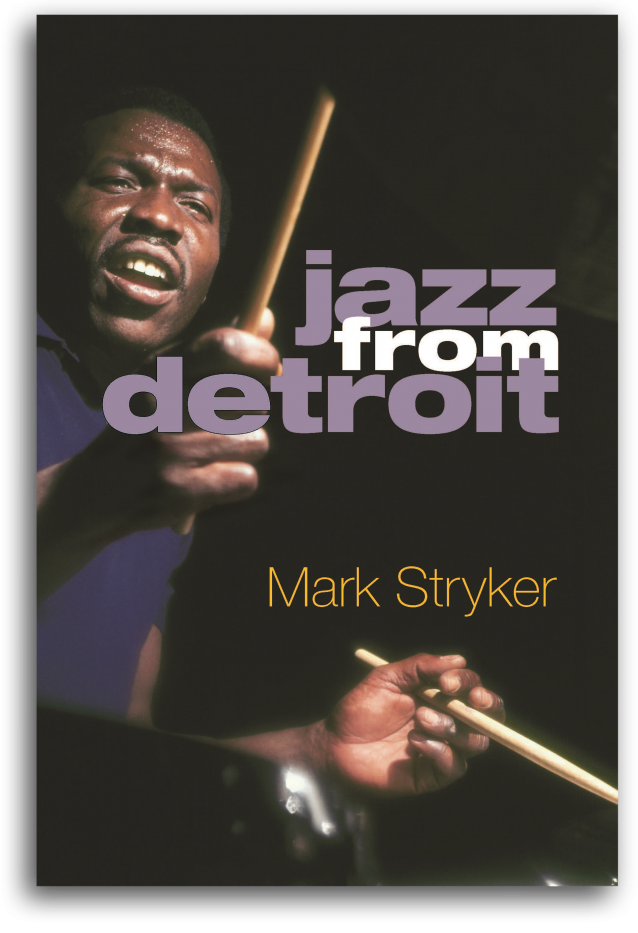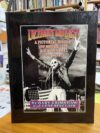Jazz From Detroit by Mark Stryker (signed)
“Deeply researched and expertly rendered, Mark Stryker’s Jazz from Detroit has provided a diligent and insightful window into every aspect of how Detroit came to be one of the major centers of modern American musical research. This is an important and highly entertaining document that will stand as a definitive testament to the musical culture of Detroit.”
— Pat Metheny
“Though Detroit is known for its legendary Motown music, former Detroit Free Press journalist Stryker’s exceptional book shows in swinging detail why the city was also a major focal point for jazz. Stryker outlines the various forces that created the conditions that spawned so many influential artists.” — Publishers Weekly
Jazz from Detroit is a landmark — the first book to explore Detroit’s pivotal role in shaping the course of modern and contemporary jazz from the 1940s until the present day. Written by an award-winning reporter and music critic with nearly 25 years of experience covering the Detroit scene, the book sweeps authoritatively through 75 years of jazz history and chronicles the indispensable contributions of dozens of musicians nurtured by Detroit. As Stryker writes in the book’s preface, “The history of jazz and the history of jazz from Detroit are indivisible. You can’t tell one story without the other.”
At the core of Jazz from Detroit are 26 in-depth profiles of key Detroit-bred musicians, complemented by a generous selection of photographs. Included are legendary figures such as Hank, Thad and Elvin Jones, Milt Jackson, Yusef Lateef, Barry Harris, Kenny Burrell, Donald Byrd, Ron Carter and Joe Henderson; underappreciated masters like Roland Hanna and Charles McPherson; and contemporary stars like Geri Allen, Kenny Garrett, Regina Carter, and Karriem Riggins. Blending vivid storytelling, exhaustive reporting and insightful criticism, Stryker digs into their lives on and off the bandstand and their impact on jazz.
But Jazz from Detroit is much more than a collection of profiles. Divided into six major thematic sections, the book connects the dots between musicians and eras as Stryker ties the development of Detroit jazz to the city’s complex history — its rise and fall as an industrial power, its turbulent racial history, and its nascent renaissance. Stryker identifies stylistic traits and attitudes that define a distinctively Detroit approach to jazz that transcends idioms and generations: an allegiance to the jazz tradition, especially bebop, as well as polished craftmanship, musical intelligence, versatility and soulful individualism. He shows how Detroit became a vital center for modern jazz and produced influential musicians for generation after generation, even as the city lost economic power and population.
Part One sets the scene by quickly surveying jazz in Detroit in the first half of the 20 the Century. Part Two digs into the golden age of the 1940s and ‘50s. A thriving black working and middle class created by the auto industry supported a vibrant nightlight and exceptional public-school music programs and key mentors in the community like pianist Barry Harris transformed the city into a jazz juggernaut. This explosion of bebop and hard bop is represented by profiles of Gerald Wilson, Milt Jackson, Yusef Lateef, Sheila Jordan, Barry Harris, Tommy Flanagan, Kenny Burrell, Donald Byrd, Roland Hanna, Curtis Fuller, Louis Hayes, Ron Carter, Joe Henderson, and Charles McPherson. Part Three is given over to the Jones brothers — Hank, Thad and Elvin — whom Stryker calls the epitome of Detroit’s jazz legacy.
As the city’s fortunes change in Part Four, Stryker turns his spotlight toward often overlooked but prescient musician-run cooperatives and self-determination groups of the 1960s and ‘70s, including the Strata Corporation, Tribe, Detroit Artists Workshop and Detroit Creative Musicians Association. In more recent decades, Detroit’s culture of mentorship, embodied by trumpeter and teacher Marcus Belgrave, ensured that the city continued to incubate influential talent in the late 20th and early 21st centuries. Part Five examines Belgrave and “his children” — protégés Geri Allen, Kenny Garrett, Regina Carter, Gerald Cleaver, Robert Hurst, Rodney Whitaker, and Karriem Riggins, as well as James Carter, who didn’t come up directly under Belgrave’s wing but absorbed his values.
Part Six brings the story up to 2019 by taking a closer look at the tradition in transion in contemporary Detroit. The resilience of the city’s jazz tradition, its ability to regenerate itself decade after decade, provides a powerful symbol of Detroit’s lasting cultural influence.
Signed by the author, mint hardcover copy, new condition in decorative covers as issued.
$ 39.95





